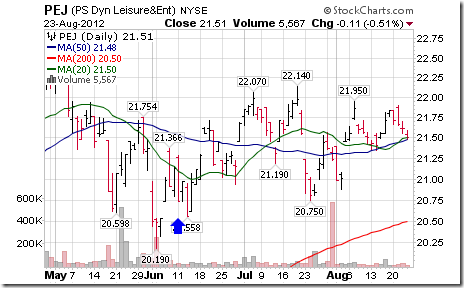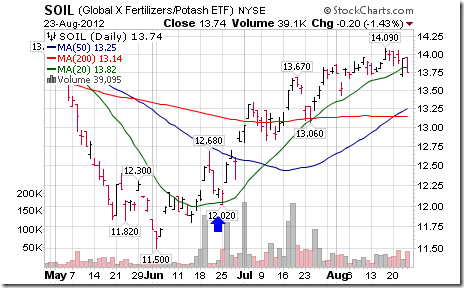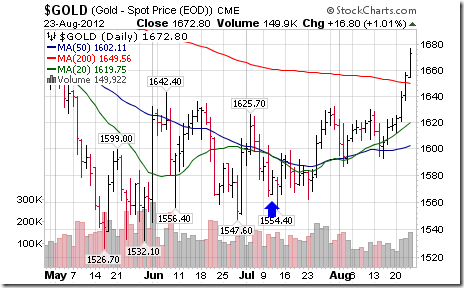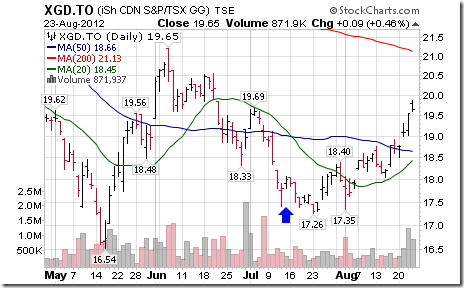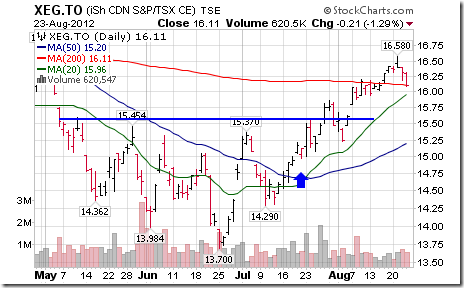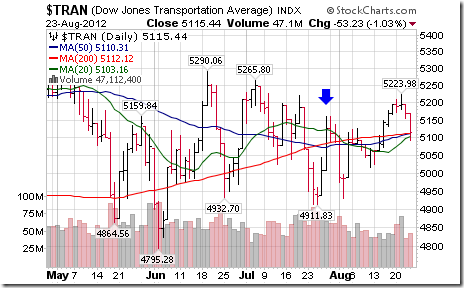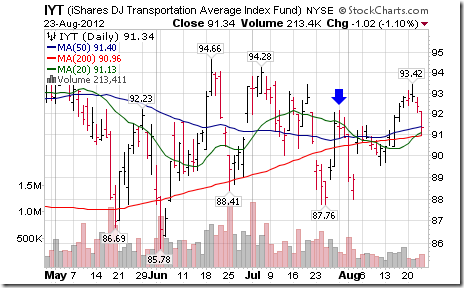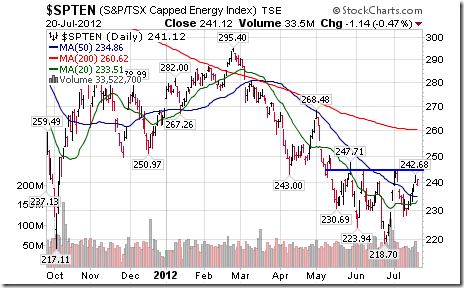The Gold Report: What’s your current outlook on metals, the economy and the general market indexes?
David Morgan: My outlook is bullish on the metals both short and long term. I think that the bottom is in for the mining equities as well as for the metals themselves. More and more people will realize that there’s really no way out of this debt-based monetary system, whether it is about the U.S. reserve currency, the Eurozone or anywhere else on the planet that uses a fiat currency. There’s a problem here and it can’t be resolved. We’re going to see more pressures to the commodity sector in general, particularly the precious metals.
TGR: In mid-May you called the bottom in the mining shares and the bullion. What leads you to make such bold calls and maintain a high degree of accuracy?
DM: I use my own indicators that come from a lot of experience. A couple of other things also keyed me. One was that the sentiment was so bad that it was screaming we are “at the bottom.” Another was that there were a few days where the volume was very, very high and there was no real buying pressure. It was short covering. Short covering at a bottom is a good indicator that the smart money or the professional money is moving out of the market. In other words, they shorted for a very long time. They made their money, they’re getting out and are covering their positions.
All these factors led me to decide to stick my neck out, which is part of the job I do, and say that this looked like a bottom to me. My experience of over 30 years in this business tells me that it usually takes about three months to confirm a bottom. I’m pretty convinced that I did get the bottom; now it’s just wait and see another month or so if I’m correct on the metals themselves.
TGR: What prices are you predicting for silver and gold?
DM: I’m looking for silver to be above $35/oz and perhaps as high as $40/oz by the end of the year. I think we could see gold at about $1,800/oz by the end of the year. We still have four months ahead of us this year and with the fix that the global economy is in, a lot of people are going to come back into what they call the fear trade, and that will lift the metals. Once gold reaches a couple of upward resistance lines, you’ll see a lot of momentum players come to the market as well for a quick trade.
TGR: Last year you were predicting $75/oz silver. What’s changed since then?
DM: What’s changed is the deflationary scare that I also talked about. It just happened to go a lot longer. I changed my mind partway through. That’s one reason why you would subscribe to something like The Morgan Report, especially if you really want the most up-to-date thinking. Basically, we saw a big push from Quantitative Easing 2, where silver went from $26/oz to $48/oz. A lot of people thought it would keep going. I called that top at that time and thought that after it ebbed and flowed we might be able to build a base quicker than we have.
Once I was able to determine that the base building would take a lot longer than I originally thought, I changed my view and said we’re going to look at probably $35–40/oz by the end of the year, not $60–75/oz. Will we ever see $75/oz silver? Absolutely. I’ve always predicted that we would see $100/oz silver as a minimum. I still think that’s low but we haven’t been there yet. So, you have to first get to $60/oz and $75/oz silver before you get to $100/oz. I’m still looking for the top to be out probably three to four years from now.
TGR: What do you see going forward into the new year? Any particular price targets for silver, gold and the white metals?
DM: I’ll be a little more conservative than I was at the beginning of this year. I think in 2013, we’ll see silver above the nominal high of $48/oz. As for gold, for 2013 I believe we’ll take out the $1,900+/oz level that gold has already achieved. I’m looking for new nominal highs in both metals in 2013. I think we’ll get far beyond that but I don’t want to put a number on it at this time. I’ve wiped enough egg off of my face this year.
TGR: Taking a macro view, what do you see in the general/physical economy from a monetary point of view?
DM: The physical economies are not doing that well in much of the world. A lot of misallocation of capital has taken place. China is a good example; it has tons of real estate that can’t be rented. The prices are too high.
Food stocks, generally speaking, are in some cases lower than they’ve been for quite some time. Energy, food and water are crucial globally and there hasn’t been enough capital movement into those essential elements. A lot of nation states are looking at what they have in the ground or are growing on the ground and are coveting their own natural resources. In the book “Resource Wars,” Michael Klare outlines the scenario of nation states going to war to either take resources that they need or defend resources that they already have. I’m not predicting war but we already see increased competition for resources.
On the financial side, the political class in every country is doing everything that they can to make this a fuzzy, mysterious problem that they’ll blame on anybody but themselves. And, of course, they’re the main culprits because they have so much control over the money supply.
So, I see the physical economy dwindling, resource wars in our future and the political class pretending as if nothing’s really wrong. Everything is going to be happy tomorrow but tomorrow never gets here.
TGR: On to the mining side. Given the upheaval we’ve seen in Argentina, Peru and most recently in Guatemala, what do you consider the most mining friendly countries?
DM: Currently, I would say Canada. We just did a piece by David Smith in The Morgan Report about the overlooked silver mining ability of Canada and mines in general. The United States still is a good place, especially if you’re a foreign investor. We have a lot of recommendations in Mexico, but I never want to have too much in any one geopolitical area. Some of the Scandinavian countries would be fine. In Africa, you have to pick and choose based on what part of Africa it is. There are resources in Africa but they’re being developed as brand new. We really don’t know how well they’ll work out because there’s not much empirical evidence yet. South Africa is a mess and getting worse. I’ve stayed away from South Africa during this bull market even though I was very heavily invested there during the first bull market in the 1970s to early 1980s. There are some exceptions, but the risk is very great.
There is a report put out by the Fraser Institute that gives its take on the most politically stable countries for mining. I don’t agree with it completely, but it’s a good start. This is an art form and not something that is scientifically derived. Investors want to be careful about the geopolitical jurisdiction because no one can call them all perfectly. Investors should not put all their eggs in one basket when you’re in the resource sector. Either have some top-tier companies, such as Silver Wheaton Corp. (SLW:TSX; SLW:NYSE) or Pan American Silver Corp. (PAA:TSX; PAAS:NASDAQ), that have assets all around the world or, if for investors picking their own stocks, use a service like ours to make sure that the investments are spread out geopolitically.
TGR: SilverCrest Mines Inc. (SVL:TSX.V; SVLC:NYSE MKT) has pretty much said it is going ahead with the aggressive expansion program over the next year and a half or so and double its metals production. What are your thoughts on this?
DM: I’ve always liked SilverCrest. This is one that we’ve had on the list for a long time. The market usually does what it’s supposed to but not always in the timeframe one would like. SilverCrest is undervalued. I believe that it is going to be a good winner for anyone who is in the stock. Doubling a mine’s production, even though it’s a small one, is quite a difficult thing to do. I’ve met with the management in Vancouver several times over the last few years. We’ve also had site visits. I like what SilverCrest is doing. I like the management; they’re very serious and know what the margins are. They know where to narrow the costs so the margins will increase.
TGR: Are there any more companies you like either in Mexico or in one of the other jurisdictions?
DM: There are two companies that I would like to mention and almost have to mention them together because both have been good to me investment-wise. First Majestic Silver Corp. (FR:TSX; AG:NYSE; FMV:FSE) is great. CEO Keith Neumeyer has done a heck of a job with the company. Its stock suffered—to our benefit—because he kept giving production targets that he missed. I suggested to him, and I don’t know if he listened to me, that he underestimate production and when the company exceeds it, the market will pay attention. The market finally caught fire and it’s been a good stock.
I’d also say Endeavour Silver Corp. (EDR:TSX; EXK:NYSE; EJD:FSE) has a great team. Some consider the company to be fairly promotional, but you’ve got to promote your product and your company. Endeavour has basically done everything it has said it would.
Both of these companies are in high growth states and I like that. So, even though they’ve moved considerably from when they first were on the list at The Morgan Report, if you’re a conservative investor and the stocks are undervalued now, which I believe both are, you can still buy these stocks.
TGR: For the more conservative investor, are there any larger-cap companies you like?
DM: There are two that I want to talk about. Franco-Nevada Corp. (FNV:TSX; FNV:NYSE) is pretty conservative. It has compounded about 20% a year. It’s run by some of the smartest people in the business and the company has a ton of cash. Franco-Nevada knows how to inject cash into certain projects so it gets a royalty stream and upside on top of the royalty stream. It’s now listed on the New York Stock Exchange.
The other one that’s been in the doldrums fairly recently and is coming out of them is Silver Wheaton. This company really knows what it is doing. It is buying streams of silver from companies all over the world. The contracts are fair to both sides in most cases. It’s really hard to be a company that knows ahead of time what the costs are for the silver going in, what Silver Wheaton pays and what the cash flow is coming out, based on the current silver price. So, you can actually do your own modeling. Investors are buying silver in the ground pretty cheap with Silver Wheaton. I like that model a great deal. I think it has a lot of merit to the upside.
TGR: Any companies in the U.S. that you would like to mention?
DM: Gold Standard Ventures Corp. (GSV:TSX.V; GDVXF:OTCQX) is one; it’s in the Carlin Trend. The people who run it are very, very knowledgeable. It’s a speculative situation—a high-risk/high-reward situation.
TGR: Any catalysts that you see coming up?
DM: Well, Gold Standard just put out some news and the market misunderstood it and the stock actually got punished for it. But on large projects, which this one has the potential to be, people don’t really understand drill results. When you have a disseminated project or an open-pit situation, it’s a far different model than a high-grade, hard-rock, narrow-vein mining situation. Grade is king. I almost always prefer hard-rock mining. But, some of these bigger projects are so robust, and with the mining techniques that we have now, they can make a lot of money. So, it’s right next to one of Newmont Mining Corp. (NEM:NYSE) mines. It could be a buyout. If you want a North American speculative play—everything else I’ve talked about is fairly conservative—you could throw Gold Standard Ventures out there.
The management is very savvy; CEO Jonathan Awde is young but he’s smart and he knows whom to hire. His geologist is one old codger and he knows what he’s doing. He’s been in that area practically his whole life. One of the richest guys in Canada has got a big bet on this company. So, there are a lot of things going for it that I like. I’m going to put a bet on this company, but, again, it is speculative, so I’m not going to risk a lot.
TGR: What is the best investing advice you have ever received?
DM: It sounds trite because it’s said and people don’t do it, but cut your losses and let your winners run.
TGR: It’s hard to do.
DM: But that’s one of the best because if you’re able to sell, you are doing the opposite of what most people do—most people sell their winners and hold their losers. No, investors should cut their losers and let their winners run because if investors have one stock that’s going to make 100 new highs over a 10-year timeframe, that’s the one you want to keep all the way up.
TGR: I think that’s great advice. Thank you for taking the time to talk to us.
David Morgan (www.Silver-Investor.com) is a widely recognized analyst in the precious metals industry; he consults for hedge funds, high net-worth investors, mining companies, depositories and bullion dealers. He is the publisher of The Morgan Report on precious metals, the author of “Get the Skinny on Silver Investing” and a featured speaker at investment conferences in North America, Europe and Asia.
Want to read more exclusive Gold Report interviews like this? Sign up for our free e-newsletter, and you’ll learn when new articles have been published. To see a list of recent interviews with industry analysts and commentators, visit our Exclusive Interviews page.
DISCLOSURE:
1) Chris Marchese of The Gold Report conducted this interview. He personally and/or his family own shares of the following companies mentioned in this interview: Silver Wheaton Corp., SilverCrest Mines Inc. and First Majestic Silver Corp.
2) The following companies mentioned in the interview are sponsors of The Gold Report: SilverCrest Mines Inc., Franco-Nevada Corp. and Gold Standard Ventures Corp. Streetwise Reports does not accept stock in exchange for services. Interviews are edited for clarity.
3) David Morgan: I personally and/or my family own shares of all of the companies mentioned in this interview. I personally and/or my family am paid by the following companies mentioned in this interview: None. I was not paid by Streetwise Reports for participating in this interview.













